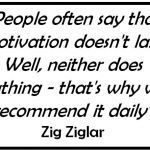Erik Qualman's Blog, page 671
February 21, 2012
2012 Mardi Gras and Fat Tuesday in New Orleans: Different?

[image error]
Mardi Gras and Fat Tuesday must be different given the proliferation of camera phones and social media
Take the omnipresence clicks of camera phones (that basically every American carries), combine that with the fast and massive reach of social media, and you would seemingly have massive impacts to the behavior exhibited at the New Orleans Mardi Gras celebration. I imagine their will be plenty of attendees that dabbled on the exhibitionist side of the Fat Tuesday celebration that now awake to find themselves being posted, tweeted and forwarded through the social media world in an unflattering light. Worse yet are the now ubiquitous HD video cameras that are embedded in most phones which leads to an even more robust experience of sight, sound and motion.
It would be interesting to see if these new technological penalties actually deter some of the craziness that happens during the two-week celebration. I would guess that once the King Cake is served and the Hurricanes start flowing, it is probably back to the 'same ole, same ole'. Too bad for some, good entertainment for many…
[image error]
Mardi Gras Fat Tuesday
[image error]
5 Facebook Page Post Ideas that you can use today!

Do you get stuck thinking of what to post on your Facebook page and end up posting something that really isn't your best work just because you want to get something up?
Quality posts are REALLY important because they are what is going to grow your page and keep those who already LIKE it coming back.
People share good posts
People comment on good posts
People like good posts
Their friends see them
It builds your page's reputation
Your page (and therefore your business) is more memorable
It positions you as an expert
Here are 5 post ideas that you could use today….
1. Ask Yes or No questions
Examples:
Do you like [insert a food/game/idea etc.]?
Do you find [insert an idea, e.g. posting/writing/drawing] easy?
Do you look forward to Monday's?
Does a glass of wine help you wind down at the end of a day?
2. Ask people to caption a photo
Find an image, it could be a still from a movie, a photo on Flickr anything, and ask your audience to caption it….
E.g.: What do you think this guy is thinking right now?

3. Either Or Questions
These work really well if you add a photo. For example with this image I might write: Which entrepreneur do you find more inspiring? or Who's book would you love to read, Richard Branson's or Steve Jobs?
4. Use a Quote
You could add it as an image and encourage sharing or as text….
5. Encourage Sharing
Insert a link to a relevant article, add a comment about your article and suggest people share it with others. You can also do this with video links and photos.
If you need more post ideas to really grow your Facebook page, I have 365 in my new ebook! Plus watch this space for more ideas in blog posts.
[image error]
Battle of the Social Media Giants: Facebook Vs. Twitter Vs. Google+

Social media has taken the world by storm in the last 5 years. It has become one of the things that have defined the early part of the 21st century. Millions of people use Facebook, Twitter and Google+ to communicate with others on a daily basis. Which company is going to become number one in the social media world?
Google+
Google+ is a relative newcomer to the world of social media. The social media platform was created in response to the growing influence of Facebook in the digital world. Google is the king of search engine providers, but Google has failed to adapt to the emergence of social media. With an estimated 40-60 million users, Google+ has about 10%of the number of users that Facebook has.
However, the backing of a large company like Google should ensure that Google+ is able to carve out a little niche in the social media world. The group hangout feature is unique among social media platforms. The ability to communicate via webcam is something that Twitter and Facebook do not have.
Twitter is as much an alternative to Facebook as it is a competitor. The main concept of Twitter is that a user can send 140 character messages to their friends. Twitter is usually billed as a text message system for the Internet as the 140 character limit is roughly the limit for most text messages. However, Twitter delivers much more than simple 140 character messages these days.
Twitter users now have a wide variety of media that they can include in each Tweet such as pictures and videos. Third party Twitter programs also allow users to create messages that are longer than the standard 140 character limits. Link shortening services also allow for more information to be packed into each message that is sent.
Sending a Tweet is not something you have to do manually anymore. There are several services that allow a user to schedule a Tweet for a specific time. If you have a lot of messages that you need to get out, it is possible these days to schedule messages in bulk. The ability to automatically send out messages adds a layer of convenience to the service.
Facebook is the king of social media. While it was originally meant to be a social service for college students, it has blossomed into the biggest social media company in the world. It is estimated that over 800 million people now use Facebook.
Facebook is so popular that other companies have been able to become successful simply by marketing its products on the site. Zynga, the company that makes games like Words With Friends and Farmville, has become a multi-billion dollar company simply by putting its products on Facebook.
The company has recently filed paperwork to go public. The IPO, which is expected to raise almost 10 billion dollars, will value the company at 100 billion dollars. This makes Facebook worth more than Hewlett-Packard and other respected American companies.
Chances are that you will go ahead and like this article when you have finished reading it, or you will share it with friends once you are finished reading. None of that would have been possible without the emergence of Facebook.
Social media is going to be a force to be reckoned with in the future. Facebook, Google and Twitter are all viable services that should be fighting for market share for years to come. It will be interesting to see how the competition between the three companies will change and alter the course of how we communicate with other on a daily basis.
My name is Nisha Sharma, I represent a site called netefffekt.com. I love to write about business tips and advice.
[image error]
February 17, 2012
Danica Patrick in the Daytona 500 is Huge for Social Media

(Video: Watch this video on the post page)
Danica Patrick has long been a media darling. And with roughly 500,000 followers on Twitter (@DanicaPatrick), she is firmly planted as a Social Media darling. But will her hype last if she cannot challenge for victories? Yes, her historic win in Japan as part of the Indy Car Series was monumental, but that was almost 4 years ago.
We can only hope she can compete and win in the upcoming Daytona 500, that would be huge for sports and NASCAR.
[image error]
Linfographic

Jeremy Lin's story told in a Linfographic [image error]
Click image to enlarge
Source: Infographic World
[image error]
February 16, 2012
How Did Teens' Facebook Photos End Up on Porn Site?

[image error]As if parents don't have enough to worry about raising kids, it was recently reported that police in one Massachusetts town were looking into how a number of female teens' Facebook profile pictures and images of them on some other social networking sites ended up on a porn site.
According to authorities, someone swiped more than a dozen Facebook profile images of fully-clothed females at Bay Path Regional Vocational Technical High School and placed them on the site with suggestive comments.
While law enforcement was still trying to determine if any crime took place, they believe the porn site, which reportedly also hosted pictures of nude children, could be located outside the U.S.
As law enforcement, school officials, parents and the teens themselves note, none of the young ladies involved gave consent to have such images and information republished on another site, an offense that some refer to as "image jacking." Police added that the privacy settings on the students Facebook accounts permitted access to the images and information.
One theory being floated about is that due to the fact all the young women attend the same school; it could be someone who has a beef with the students or school that provided the pictures to the site. The students, meantime, have been advised to be more cautious as to what they post on their Facebook pages and in other social media circles.
Some free-speech backers reportedly said that if there was nothing inherently sexual about the pictures, it does not matter how they were used, even with suggestive titles attached to the images.
At the end of the day, both parents and teens (male and female) need to be cautious with what is posted on social media sites. That being said, should parents prohibit their kids from having Facebook, Twitter and other social networking pages in the first place?
Given today's technologically-driven world, there are many benefits that come with kids learning computers and the world of social media at an early age.
The young ladies in this situation did nothing wrong, yet the psychological damage could linger well into the future.
Photo credit: CBSNews.com
[image error]
Funny Video about Verizon 4G via @SNL

Are you confused by 3G, 4G, LTE jargon? Or do you have a tough time explaining it to your parents or grandparents. Apparently you aren't alone as this funny Verizon video spoof by our friends at SNL point out:
[image error]
February 15, 2012
The Power of foursquare: Best Practices from Carmine Gallo, author of The Power of foursquare

In later October our community had the chance to connect with Carmine Gallo, the author of The Power of foursquare, during a well-attended webinar on The Power of foursquare: 7 Innovative Ways to Get Your Customers to Check in Wherever They Are. Our friends, followers and customers learned the importance of incorporating foursquare, the fastest growing location-based service, into their social media marketing efforts. I recalled the excitement about the vast opportunities related to location-based networks like foursquare when Mike Schneider discussed key takeaways from his book Location-Based Marketing for Dummies at our Awareness Social Media Business Summit. Social marketers are clearly seeing the potential of engaging with customers on the go – in 2010 alone, there were 381 million check-ins on the foursquare platform alone. That number climbed to 1 billion in 2011.
In this blogpost we'll share the power of C-H-E-C-K-I-N, or the seven ways to unlocking your business potential by using foursquare: Connect with Your Brand, Harness New Fans, Engage Your Followers, Create Rewards, Knock-Out the Competition, Incentivize Your Customers, Never Stop Entertaining, based on Gallo's The Power of Foursquare.
Connect with Your Brand
If you're a restaurant owner or a coffee shop, you can easily draw in patrons with a free drink or dessert. But what if you're in real estate agency? How do you get noticed and stay top of mind with potential customers? Corcoran Group, one of the premier real estate groups in New York City, used clever listening to unearth opportunities to provide useful city information to potential buyers and introduce their brand to them. Corcoran mined hard-to-find insights about special offers in the city and in turn provided "insider" tips to NY residents through foursquare. They discovered that The Shake Shack, a very popular burger joint, was near one of Corcoran's Manhattan offices. With its excessive lines, The Shake Shack can sometimes experience excessive lines with waiting times of up to 45 minutes. Corcoran found out there was this secret line called the B-line, where patrons can order anything else on their menu except a burger in no time. Corcoran then used this information to tip the Shake Shack patrons about the B-line. By being plugged into their community and understanding the pain points of their potential customers, Cocoran was able to connect with them in a clever way and create a positive connection and experience with their brand – so when Shake Shack customers are looking for real-estate help, they would think of the Corcoran Group. Clever, indeed.
Harness New Fans
Carmine shared a personal anecdote of how a clever use of foursquare by a local restaurant in San Francisco had him, his wife and some friends, spent more on a meal than they were planning to. While checking into the restaurant, he noticed Max's on The Square was offering a special on the ultimate chocolate cake. This special offer caught the group's interest and they ended up ordering the dessert – which turned out to be pretty good.
Engage Your Followers
Don't be quick to conclude that location-based services are good for coupons only. foursquare can be used to build meaningful connections with your customers via clever use of unique content. For example, UC Berkeley uses foursquare to offer historical tips about various locations on their campus. A coffee shop may looks like any other on the outside but should you check into its location via foursquare, you will learn about its role during the Free Speech Movement (FSM).
Create Rewards
foursquare offers unique ways to pay tribute to and recognize your most loyal customers. Take note of how one Baltimore restaurant, Miss Shirley's, did not get sidetracked by its popularity and offered a special way to treat its most loyal customers – their foursquare mayors. Miss Shirley's patrons do not have to line up for the restaurant's popular brunches – in fact they priority seating for them and up to three of their friends. Or learn from AJ Bombers in Milwaukee who frequently utilizes "swarm" rewards via foursquare. People who check in at the same time are organized into groups and offered a special. The owner attributes Foursquare to 30-50% of his profits. As Gallo put, quoting Naveen Selvadurai, the co-founder foursquare: "When you're the mayor you might be the coolest person in the room for five minutes. Who doesn't want recognition?"
Incentivize your Customers
You don't always need to incentivize with free drinks or food. Citing a non-profit called Earth Justice, Gallo shared that, in a two-week foursquare promotion, the non-profit raised $50,000. Earth Justice rented billboards around San Francisco and allowed people to check into them – in return, for each check-in they had an anonymous donor donate $10 to a cause. In another successful ROI story, Radio Shack calculated that customers who unlock a foursquare special spend 3.5 times more than their average customer.
Never Stop Entertaining
A designer shoe icon made popular by 'Sex and the City,' Jimmy Choo held a foursquare promotion in London to celebrate the launch a new $500 shoe model. Shoppers were encouraged to check-in to one of Choo locations to win a free pair. The result – 4,000 people checked in during the two-week period, and sales of that shoe model went up 33%. Engaging your customers in a fun way attracts attention to your brand and helps drive sales.
Five Pitfalls to Avoid
As with any other platform, foursquare requires some careful planning. Gallo pointed out a few critical areas brands need to consider:
No employee training: Employees need to be informed and trained to how to properly execute your foursquare initiatives.
Lame Specials: Don't ask customers to check in 10 times before giving a discount. Offer meaningful incentives.
Ignoring the Mayor: You may think this is an obvious one but lots of businesses don't recognize their mayors. Treat your most loyal customer with the utmost respect.
Poor Customer Service: Make sure you have your house in order before opening up the world to it. If foursquare members have a bad experience, they will not come back – in fact, they may tarnish your brand reputation.
Doing it just to do it: Do it because you believe in it, not because it's the hot new marketing tool.
Have you had success with foursquare? Planning new, exciting campaigns on the platform? Share your best practices, success stories and question with our community on Twitter, Facebook at Awareness, Inc., Social Media Marketing Best Practices and Social Media Marketing Mavens pages, and in our LinkedIn Social Media Marketing Mavens Group.
Mike Lewis
@bostonmike
[image error]
Jeremy Lin: Lin-Sanity hits Twitter @JLin7

[image error]
Jeremy Lin #17 top selling NBA jersey
Jeremy Lin, the movie, coming to theaters near you. If you haven't heard of the New York Knicks Jeremy Lin, then you live in the North Pole. Just a few weeks ago, Lin tweeted @JLin7 Everytime i try to get into Madison Square Garden, the security guards ask me if im a trainer LOL. Lin is still couch surfing on his brother and teammates couches yet his Twitter followers have grown overnight to nearly 300,000 people and include celebrity followers like Bill Cosby and Spike Lee.
Just as Tim Tebow captured a nation, Linsanity has captured the world. The New York Knicks new star has caused television ratings for the NBA in China to increase 35%. Wether you prefer Lin-sanity, Lin-possible, Linning, Lincredible, the media hype hit a fever pitch last night when Lin hit the game winning shot against the Toronto Raptors. Just last Friday Lin outscored the Lakers' Kobe Bryant 38-34 in a nationally televised game. There are so many factors and layers to the Jeremy Lin story that when combined they make the story an 11 on a scale of 10.
Jeremy Lin Bio:
Lin wasn't recruited out of high school even though he won a state championship
Lin is from Palo Alto – the home of Facebook and Stanford
Lin played at Harvard which has produced more presidents (8) then NBA players (4)
Lin spent one summer as an intern in the California Governor's Office making copies & coffee
Lin was undrafted out of Harvard
Lin was cut from the Golden State Warriors and Houston Rockets this year
Just days ago Jeremy Lin was going to be cut from the Knicks until some players were injured
Jeremy Lin is the first Asian-American to play in the NBA
Lin scored the most points in his first five games than any player in NBA history (more than Jordan, Magic, LeBron, Bird…anybody!)
Like Tebow, Jeremy Lin is a devote Christian (see @JLin7 Twitter image)
Lin's #17 New York Knicks Jersey was the top seller in the NBA last week
[image error]
Jeremy Lin shows his humorous and Christian side with his @JLin7 Twitter image
It's a Cinderella story with it's own special digital and Silicon Valley twist. The world roots for a kid that was virtually unwanted in the basketball world for twenty years. While others thought he'd make a brilliant engineer some day, Lin stuck with his dream and it has finally come true. This is something that everyone in the world can not only relate to, but cheer for. In fact, in the game against the Raptors on Valentine's Day, more people were cheering for Lin than for the hometown Toronto Raptors. The NBA somehow doesn't have the ability to shift its nationally televised games to take advantage of Lin, but he will be on TV this Sunday agains the Dallas Mavericks at 1 pm EST. I'm Lin-sane in the membrane, are you?
[image error]
Jeremy Lin-sanity: When will it end? Hopefully not anytime soon.
[image error]
February 14, 2012
Social TV: Social Marketing Practices That Translate Beyond Television

For us marketers engaging in a dialogue with your key audience and cultivating that ongoing relationship is crucial to maintaining brand awareness and loyalty. Social TV is no exception. In the largely uncharted waters of social media, Social TV is an arena marketers can no longer afford to ignore. People are using this space at a rapidly growing rate, and certain television networks, like Discovery Communications, LLC and USA Networks, are reaping the benefits. In this post, I'll discuss what Social TV is reviving an industry, pronounced by many pundits as slowly dying. What can we as brand marketers learn from this Social TV revolution in media? Plenty.
What exactly is Social TV?
By now, I'm sure you've seen them on your favorite TV shows. Intruding ever so slightly, it's there, on the bottom right hand corner of the screen, pulsing in and out of visibility: the hashtag. Those who are not well adverse in social media often dismiss or don't even see it on the screen. But to an ever-increasing population, it signals a conversation going on that you don't want to miss. Social TV is a term used to describe both the technology and processes that allow social interaction amongst fans, TV producers, and distributors…on the TV screen. Featured in The Social Media Monthly October 2011 issue, the article "The New Fall Season: Social TV poised to change how we find, purchase, and consume television," by Carri Bugbee, boasts The MIT Technology Review listed Social TV as one of the "ten most important emerging technologies in 2010." Television viewing has always been a social phenomenon, but the birth of Tivo, DVR and YouTube, has stagnated our "water cooler" moments – the "Who shot JR?" moment or the blackout ending of The Sopranos finale. Social TV has brought these moments back to us in a newer and re-imagined way with some impressive statistics:
According to Carri Bugbee, the #TrumpRoast hashtag was used more than 27,000 times on Twitter during the March 2011 telecast of the Comedy Central Roast of Donald Trump. Apparently that was the most-watched Tuesday night show in the history of the network.
Fox's 'The X Factor' is No. 1 among new series, with an average of 94,000 social comments per episode as recorded by Bluefin.
The Old Spice The Man Your Man Can Smell Like campaign generated:
5.9 million views on YouTube.com in the first 24 hours of launch
20 million views 3 days after launch
1.4 billion impressions over 6 months
Sales increase by 107% over 6 months
It seems Social TV offers a place for fans to interact over favorite programs both in real-time and on a grand scale. This type of connectivity gives networks insight not only as to how people are watching and consuming media but also their degree of engagement, insights that were previously inaccessible. Emerging from the pack, Discovery Communications, LLC is creatively engaging in the conversation with viewers and building a growing network of fans.
According to Gayle Weiswasser, Vice President, Social Media Communications at Discovery Communications, social media has made TV a social experience again. With its vast assortment of networks – from Discovery Channel, Animal Planet, and TLC– the company manages 70 Facebook Fan pages boasting 40 million fans, and 20 Twitter accounts with 2.4 million followers. Gayle shared that their philosophy on social media is "to use it as a platform that enhances the viewing experience and the relationship with the viewers".
Part of cultivating that relationship through blogposts, sneak peaks, photos from show talent and more, requires a kind of content producing powerhouse that goes above and beyond a show's storyline or premise. For example, Discovery's What Not To Wear Facebook Fan Page (over 800,000 fans at the time of writing this blogpost) links to articles about fall fashion trends, while the DC Cupcakes Facebook Fan Page features mouth-watering recipes (over 160,000 fans). Lauren Drell from Mashable quotes Weiswasser as saying "content may not have anything to do with the show, but it is relevant to our viewers." Weiswasser attributes their success to four easy steps:
Building relationships and engaging with fans
Personalizing the brand
Strengthening fan-talent relations
Driving tune-in
By far, the most successful social media campaign on Discovery's resume is the Shark Week promotion. During the week of air in July 2011, there were more than 750,000 tweets mentioning Shark Week — an eight-fold increase over last year — and the handle @SharkWeek grew to close 60,000 followers.
The Shark Week Photo Frenzy – a call for fans to submit photos of how they celebrate Shark Week, got 600,000 page views and more than 1,000 submissions, in addition to 80,000 views of the Photo Frenzy tab on Facebook (Drell). The Facebook Page accrued 30,000 fans in a single day (116,000 fans throughout the week). The result? 3.9 million viewers for opening night, the highest number in Shark Week history, coming in at a 2.8 for the 9-11pm time slot. Part of the high rating can also be attributed to a well-executed app that lets viewers participate in social conversations on their computers, iPhones and iPads.
This balance between content generation and allowing fans to shape the course of content has proven to be a powerful exchange for Discovery Communications. Because of social media, Discovery and other networks can now listen to that social discourse, the "likes" and "dislikes," and mold their content to drive ratings. "We want the content to speak for itself," says Weiswasser. "If it's compelling, people will want it — that's how we got this footprint" (Drell).
What can brand marketers learn from this?
While Discovery Communications is not the only network finding success with social marketing campaigns, they provide a good example of how brands can market successfully with social media. For a network, the outreach – the blogs, photo campaigns, Twitter postings, Facebook engagement, etc. – becomes an extension of their storyline. Using the television show as the initial premise behind their social media marketing, they broaden those topics to deliver more relevant content for viewers with intent on keeping viewers coming back to the shows.
Just as Old Spice became a phenomenon through a social TV lens, so can other brands. But it begins with good content – The Man Your Man Can Smell Like campaign wouldn't have been nearly as successful without the right actor, a pithy, witty script, and the medium (YouTube in this case). The other key factor in making this campaign a huge success was singling out their key audience, in this case, women – but while still appealing to men. The initial commercial was not only funny but it drove home the point that real men don't use women's body wash and if you want your man to live up to his potential, he needs his own.
These are definitely lessons we hear all the time – content is key, go beyond your initial product to further engagement — but what networks are discovering through Social TV is that their social outreach may be equal or even more important than the actual product of their shows. Old Spice followed up their initial commercial with several vignettes using the same actor and premise. The goal of their first commercial was to increase sales but they did more than creating one successful commercial. They personalized the brand, giving it dimension and a story arc that extends beyond its first inception. This three-pronged attack pushed the campaign from successful to legendary.
Got a favorite TV show that keeps on living in the social realm? Using Social TV to engage fans and keep them coming? Share your insights, experiences and questions on this blog, Twitter: Facebook at: Awareness, Inc., Social Media Marketing Best Practices and Social Media Marketing Mavens pages, and in our LinkedIn Social Media Marketing Mavens Group.
Mike Lewis
@bostonmike
[image error]



